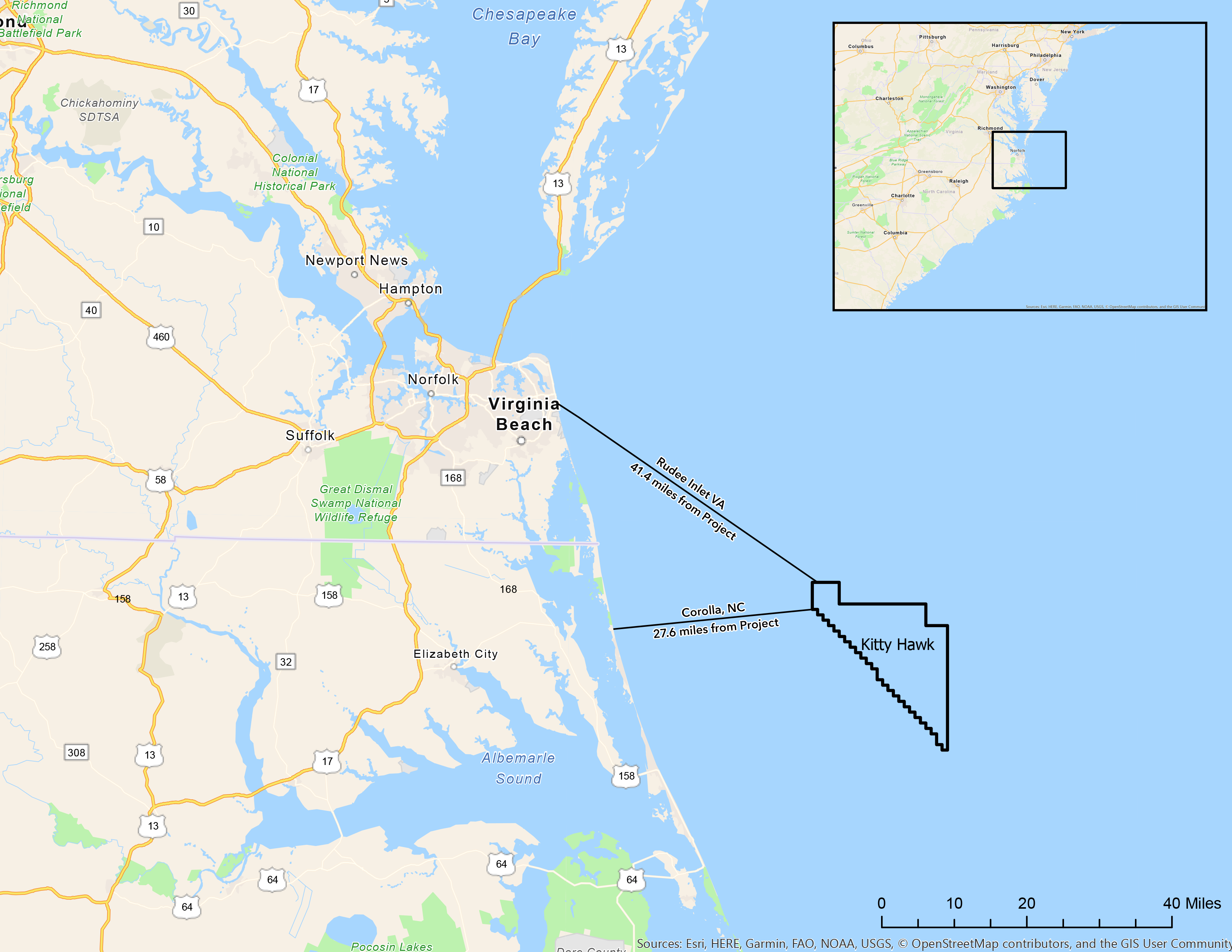This blog post was co-written by SACE Renewable Energy Manager Simon Mahan and Coastal Climate & Energy Manager Chris Carnevale.
North Carolina’s first offshore wind lease sale was held today and Avangrid Renewables was named provisional winner of the lease sale, having offered the high bid of $9,066,650, outbidding three other companies. As the provisional lease holder, Avangrid will have the ability to propose site assessment activities, such as collecting meteorological and wildlife data, in the lease area. The lease area, known as the Kitty Hawk Wind Energy Area, consists of 122,405 acres in the Atlantic, east of Currituck Sound, about 24 nautical miles from shore at its closest point to shore.

Avangrid just completed North Carolina’s first onshore wind farm, the Amazon Wind Farm U.S. East, in northeastern North Carolina, near Elizabeth City. The 208-megawatt wind farm powers an Amazon Web Services data center in nearby Virginia with the amount of electricity that would be equivalent to about 61,000 homes’ worth of power per year.
While Avangrid is the provisional winner of the lease, they are not yet permitted to build a wind farm. Rather, there will be several steps of public input, environmental review, and regulatory oversight before the company could be allowed to officially begin wind farm construction. What Avangrid will be allowed to do once the lease is executed, is begin putting together their Site Assessment Plan (SAP), detailing how the company intends to carry out site assessment activities of the lease area. The SAP will be submitted to the Bureau of Ocean Energy Management (BOEM), the federal regulatory agency tasked with overseeing offshore energy, for approval before any such activities will be permitted. We expect the site assessment activities to last a couple years before the company would officially propose their wind farm in the form of a Construction and Operations Plan (COP).
The specifics of any potential wind farm will not be known for quite some time, but we do know some basic information about the lease area and its capabilities for hosting a wind farm. The Kitty Hawk lease area is a little over 122,000 acres, or nearly 500 square kilometers. With an offshore wind carrying capacity of roughly 3-5 megawatts per square kilometer, the Kitty Hawk area could represent about 1,500-2,500 megawatts of wind power capacity. Each megawatt of capacity built would generate approximately the amount of electricity used by 300 homes each year, so the site could power up to 450,000 to 750,000 homes if fully built out. Based on data available from the National Renewable Energy Lab, the area may support average wind speeds of roughly 8.5 meter per second (19 MPH), with annual capacity factors over 42%. For comparison, the Amazon wind farm that Avangrid recently completed near Elizabeth City, North Carolina, has estimated wind speeds of 7 m/s (15.6 mph), but expects about a 37% annual capacity factor.
While the wind resources are better offshore, they don’t always equate to lower costs when compared to onshore wind farms. Offshore wind turbines and onshore wind turbines are built differently since the offshore environment poses unique challenges and demands special engineering. Higher wind speeds also mean wind turbines have to be constructed with additional reinforcement. Additional turbine reinforcement can increase weight, and reduce efficiency at generating power. Then there are additional costs associated with construction and operations in a marine environment, not to mention the lengthy federal leasing process.
The United States’ first offshore wind farm went online in December 2016. The Deepwater Wind project off Block Island, Rhode Island, is a six-turbine, 30 megawatt project that cost approximately $300 million. However, as a first-of-its-kind project, costs are anticipated to decline for future offshore wind farms, particularly for larger projects that can harness economies of scale. European offshore wind projects are already about 60% lower cost than the Block Island project. In 2016, Europe invested in 4,948 megawatts of offshore wind capacity at a cost of about $19.4 billion (€18.2 billion) – or roughly $4 million per megawatt installed. The Block Island project cost about $10 million per megawatt. Lawrence Berkeley National Lab estimates offshore wind prices will drop by 30%, or more, by 2030. The projection of falling costs for offshore wind in the United States is supported by the trend seen in Europe, where as the industry and technology have matured, costs have fallen. Bloomberg New Energy Finance reports that “Across Europe, the price of building an offshore wind farm has fallen 46 percent in the last five years — 22 percent last year alone.”
But offshore wind farms do have unique benefits compared to other sources of power generation. For instance, offshore wind farms can help improve and revitalize coastal and port-dependent economies. Also, offshore winds tend to blow strongly in the late summertime afternoons, when electricity use is at its highest and utilities are willing to pay a premium for power. Harnessing offshore wind to produce that “peak” power could replace even more expensive and highly polluting “peaker plants” and actually save power companies and customers money. Finally, coastal communities tend to be heavy power users, so locating a wind farm near existing power loads is very beneficial. The United States Department of Energy has evaluated scenarios where offshore wind may reach 54,000 megawatts of capacity installed in the United States by 2030.
The vast majority of Americans like wind energy resources, and we’ve even seen some tourism interest developed out of new wind farms. But no one, single, energy resource is ideal for a sustainable energy future. To power our energy future, we’ll need a good mix of onshore and offshore wind farms, solar panels, energy efficiency and other technologies to supply low-cost power.
SACE would like to congratulate Avangrid for winning the Kitty Hawk lease sale and is looking forward to working together, along with many other stakeholders, to begin to harness the immense offshore wind resources of the Southeast.